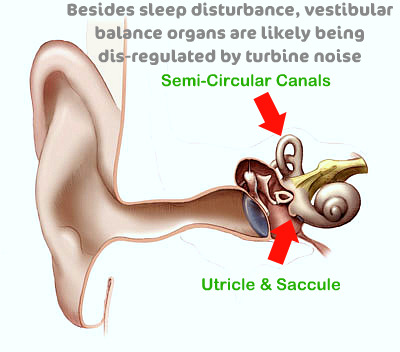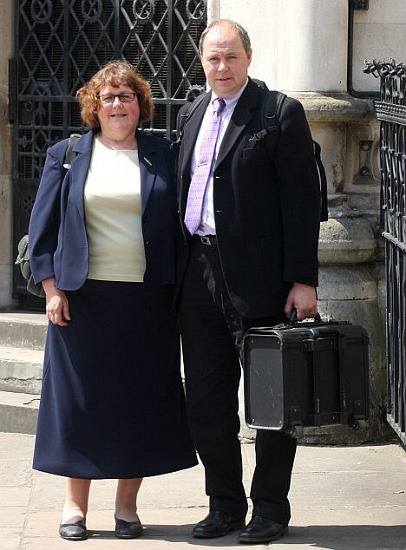UK government fudges wind turbine noise report (United Kingdom)
Dec 16, 2009
·
“Officials cover up wind farm noise report”
—Jonathan Leake & Harry Byford The Sunday Times (United Kingdom), 12/13/09
“Civil servants have suppressed warnings that wind turbines can generate noise damaging people’s health for several square miles around. The guidance from consultants indicated that the sound level permitted from spinning blades and gearboxes had been set so high—43 decibels—that local people could be disturbed whenever the wind blew hard. The noise was also thought likely to disrupt sleep.
“The report said the best way to protect locals was to cut the maximum permitted noise to 38 decibels, or 33 decibels if the machines created discernible ‘beating’ noises as they spun.

Editor’s note: This image was added by WTS.com.
“It has now emerged that officials removed the warnings from the draft report in 2006 by Hayes McKenzie Partnership (HMP), the consultants. The final version made no mention of them. It means that hundreds of turbines at wind farms in Britain have been allowed to generate much higher levels of noise, sparking protests from people living near them.
“In their draft report the HMP researchers recommended that ‘consideration be given to a revision of the night-time absolute noise criterion,’ noting that this would fit with World Health Organisation recommendations on sleep disturbance. However, an anonymous government official then inserted remarks attacking this idea because it would impede wind farm development. He, or she, wrote: ‘What will the impact of this be? Are we saying that this is the situation for all wind farms, just these [i.e., the three wind farms in the HMP study], a % only for people with sensitive hearing, a problem with older turbines–I think we need a sense of the scale of this and the impact.’ The final report removed any suggestion of cutting the noise limits or adding any further penalty if turbines generated a beating noise—and recommended local authorities to stick to the 1996 guidelines.” (Emphasis added.)
»»»»»»»»»»»»»»»
Below is the full article–Editor
Civil servants have suppressed warnings that wind turbines can generate noise damaging people’s health for several square miles around.
The guidance from consultants indicated that the sound level permitted from spinning blades and gearboxes had been set so high—43 decibels—that local people could be disturbed whenever the wind blew hard. The noise was also thought likely to disrupt sleep.
The report said the best way to protect locals was to cut the maximum permitted noise to 38 decibels, or 33 decibels if the machines created discernible “beating” noises as they spun.
It has now emerged that officials removed the warnings from the draft report in 2006 by Hayes McKenzie Partnership (HMP), the consultants. The final version made no mention of them.
It means that hundreds of turbines at wind farms in Britain have been allowed to generate much higher levels of noise, sparking protests from people living near them.

Jane & Julian Davis (Photo used with appreciation)
Among those affected is Jane Davis, 53, a retired National Health Service manager, who has had to abandon her home because of the noise.
It lies half a mile from the Deeping St Nicholas wind farm in south Lincolnshire whose eight turbines began operating in 2006.
“Our problems started three days after the turbines went up and they’ve carried on ever since. It’s like having helicopters going over the top of you at times—on a bad night it’s like three or four helicopters circling around,” she said.
“We abandoned our home. We rent a house about five miles away—this is our fourth Christmas out of our own home. We couldn’t sleep. It is torture—my GP describes it as torture. Three hours of sleep a night is torture.”
The HMP report was commissioned by the business department whose responsibilities for wind power have since been taken over by Ed Miliband’s Department of Energy and Climate Change (DECC).
The decision to stick with existing noise limits became official guidance for local authorities ruling on planning applications from wind farm developers.
It has also been used by ministers and officials to support the view that there was no need to revise official wind farm noise guidelines and that erecting turbines near homes posed no threat to people’s health and wellbeing.
In 2007 Mike Hulme of the Den Brook Judicial Review Group, a band of residents opposing a wind turbine development close to their houses in Devon, submitted a Freedom of Information request asking to see all draft versions of the study.
Officials refused the request, claiming it was not in the public interest for them to be released. Hulme appealed to the information commissioner’s office, which has ordered Miliband’s department to release the documents. The drafts show the HMP originally recommended that the night-time wind turbine noise limit should be reduced from 43 decibels to 38, or 33 if they made any kind of swishing or beating noise—known as “aerodynamic modulation.”
The HMP researchers had based their recommendations on evidence. They took noise measurements at houses close to three wind farms: Askam in Cumbria, Bears Down in Cornwall and Blaen Bowi in Carmarthenshire.
They found that the swish-swish signature noise of turbines was significantly greater around most wind farms than had been foreseen by the authors of the existing government guidelines, which date from 1996. They also found that the beating sound is particularly disruptive at night, when other background noise levels are lower, as it can penetrate walls.
In their draft report the HMP researchers recommended that “consideration be given to a revision of the night-time absolute noise criterion,” noting that this would fit with World Health Organisation recommendations on sleep disturbance.
However, an anonymous government official then inserted remarks attacking this idea because it would impede wind farm development. He, or she, wrote: “What will the impact of this be? Are we saying that this is the situation for all wind farms? . . . I think we need a sense of the scale of this and the impact.”
The final report removed any suggestion of cutting the noise limits or adding any further penalty if turbines generated a beating noise—and recommended local authorities to stick to the 1996 guidelines.
Hulme said: “This demonstrates the conflict of interests in DECC, because it has the responsibility for promoting wind farm development while also having responsibility for the wind farm noise guidance policy . . . meant to protect local residents.”
Ron Williams, 74, a retired lecturer, lives half a mile from the Wharrels Hill wind farm in Cumbria. He has been forced to use sleeping pills since its eight turbines began operating in 2007.
“The noise we get is the gentle swish swish swish, non-stop, incessant, all night,” he said. “It’s like a Chinese torture. In winter, when the sun is low in the sky, it goes down behind the turbines and causes flickering shadows coming into the room.
“It’s like somebody shining car headlights at your window . . . on and off, on and off. It affects us all. It’s terrible. Absolutely horrible.”
Lynn Hancock, 45, runs a garden maintenance business. She has suffered disruption since 2007 when the 12-turbine Red Tile wind farm began operating several hundred yards from her Cambridgeshire home.
“Imagine a seven-ton lorry left running on the drive all night and that’s what it’s like,” she said. “People describe it as like an aeroplane or a helicopter or a train that never arrives. It’s like it’s coming but it never gets here.”
Such problems are likely to increase. Britain has 253 land-based wind farms generating 3.5 gigawatts, but this is expected to double or even triple by 2020 to help to meet targets for cutting CO2 emissions.
»»»»»»»»»»»»»»»
The following is a commentary on the released documents, by the Den Brook Judicial Review Group, the group that successfully procured these documents under Freedom of Information laws. This commentary can be read in full by clicking here. For the relevant emails and other documents “sprung” by Mr. Hulme from the government, visit National Wind Watch (click here) and scroll to the bottom of the page.
WTS.com has excerpted the “Health Comment Removed” section, a matter we find especially alarming–Editor.
—by the Den Brook Judicial Review Group
Health Comment Removed
Although the original purpose of the study was to examine the potential health effects of wind farm noise, the Information Commissioner’s report notes that it is not a statutory duty of DECC (or its predecessor departments, BERR and the DTI) to set noise policy or noise limits. This responsibility resides with DEFRA. However, DECC is charged with removing barriers to the expansion of wind farms in the UK and takes upon itself responsibility to ensure that the wind farm noise guidance known as ETSU-R-97 is up-to-date and robust.
DECC [Ed Miliband’s Department of Energy and Climate Change] stated that HMP [Hayes McKenzie Partnership], an independent acoustics consultancy, albeit with no expertise in the area of public health, was commissioned to carry out the study into the potential health effects of wind farm noise because there were no DTI [Department of Trade & Industry] staff with relevant expertise to do this work.
Mr. Hulme [the individual who successfully filed the lawsuit for the release of these documents], in arguing that the drafts should be released, quoted the then Minister for Energy in a House of Commons debate of 5 July 2007, in which he relied on the findings of the HMP report to support his statement that there is ‘no evidence of adverse health effects from wind turbines.’ Mr. Hulme argued that the public was entitled to know on what basis the Minister for Energy could make such a confident assertion.
The Information Commissioner accepted Mr Hulme’s point and added that disclosure of the report drafts would increase public confidence if it was revealed a careful drafting and review process had occurred or, alternatively, if it was revealed that the drafts were not subjected to adequate scrutiny then it could be argued that it would be in the public interest to disclose the drafts in order to reveal these failures.
None of the released information includes evidence that scrutiny by health experts was carried out, nor does it provide comments indicating a peer review process. Indeed, the only input appears to be the anonymous official’s comments on the released draft [see below], which are particularly negative about a reference to health effects. The HMP study noted that audible wind turbine noise within a bedroom resulted in the occupants finding it difficult to return to sleep if woken during the night. The draft report observed:
A difficulty in returning to sleep will result in tiredness the next day and all the associated descriptions of ill-health which might be associated with a lack of sleep.
This remark was removed, after the following response from the anonymous official:
This sentence is dangerous and could be read that wind farms cause ill-health, which is not the intention. We need the report to stick to the facts that LFN is below the guidelines, but that once woken by a car there may be problems getting back to sleep for those with sensitive hearing as result of the windfarm–something like that.
This is a remarkable statement and demonstrates the conflict of the roles adopted within the DTI, and now DECC, of promoting wind farm development while also having responsibility for the wind farm noise guidance policy intended to protect local residents.
Editor’s note: Who was this anonymous individual–this pseudo-scientist? Talk about junk science! In America this person would be tarred and feathered.
·
